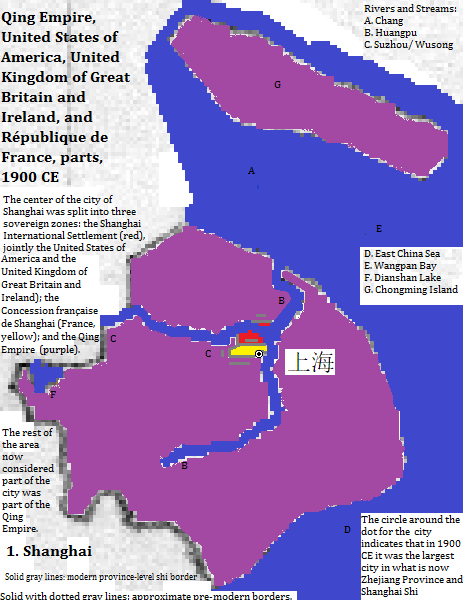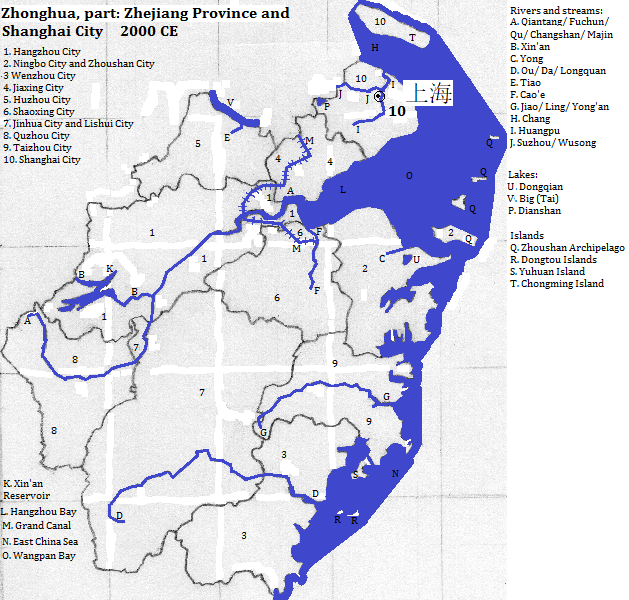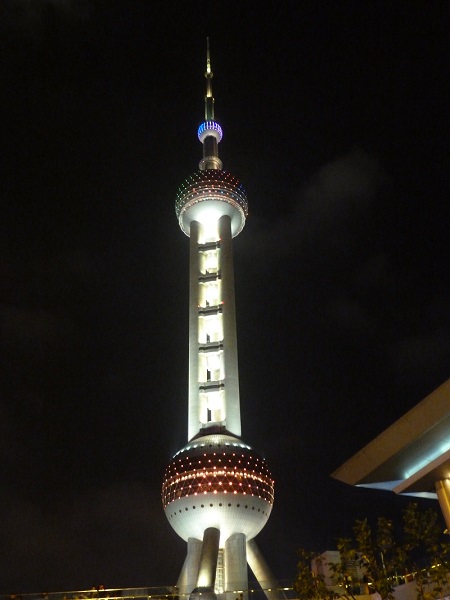上海 (Shànghăi)
上海1 (Shànghăi) is a port centered on the Huangpu River close to the mouth of the Chang (Yangzte). It has over 23 million metropolitan and city residents.2 The tallest building is the 上海 (Shanghai) Tower (2074 feet, 2015), which boasts the world's fastest elevator (as of early winter, 2016). The next tallest is the 上海 (Shanghai) Financial Center (1622 feet, 2008). The third tallest structure is the Oriental Pearl TV Tower (1535 feet, 1994), with its distinctive spire with spheres.3 The Pudong skyline is a tourist attraction.4 The city is served by two major airports: the 上海 (Shanghai) Pudong International Airport and the 上海 (Shanghai) Hongqiao International Airport, both among the nation's busiest.5
The city became prominent in the 19th century, when the Americans and British (jointly) and the French occupied portions of it. After 1949 all of it was part of the 中华 (Zhōnghuá People's Republic).
There is a bridge across Hangzhou Bay connecting to Ningpo.
| Year | Population | Political entity |
| 1900 CE | 619,0006| Qing Empire (China), the United States of America, the United Kingdom of Great Britain and Ireland (British Empire) and the Républic de France | |
| 2000 CE | 11,947,0007| 中华 (Zhōnghuá or Chinese) People's Republic) | |



Oriental Pearl TV Tower, 上海 (Shànghăi), 中华 (Zhōnghuá) People's Republic
Footnotes
1. Shànghăi or Shang-hai in transliterated Pŭtōnghuà Chinese. The first character means above and the second sea, so a reasonable translation is Upon-the-Sea. In the Shanghai dialect of the Wu dialect group it transliterates as Zånhae.
2. The metropolitan population is the same as there are no quan within the shi and they are how I choose to restrict my definition of a metropolitan area within the shi. Since the only qu (Qingpu) that borders Suzhou Shi's core is a suburban one, I do not extend the definition of the metropolitan area beyond the shi. The source is https://en.wikipedia.org/wiki/Shanghai, accessed July 31 and August 2, 2016, which cites the 2010 census. The city was the largest in what is now the combined area of the provincical-level shi and 浙江 (Zhèjiāng) Province in 2000 CE. Well before 2000 CE it had over a million residents.
3. Information about buildings is from emporis.com, accessed December 5, 2016.
4. http://www.touropia.com/tourist-attractions-in-china/--Shanghai one, accessed August 3, 2016.
5. https://en.wikipedia.org/wiki/List_of_the_busiest_airports_in_China, accessed August 3, 2016: 2015 table of top 50.
6. Tertius Chandler, Four Thousand Years of Urban Growth, 2nd ed. (The Edwin Mellen Press, 1987), "Tables of World's Largest Cities". In 1900 it was already the largest city in what is now the combined area of the provincical-level shi and 浙江 (Zhèjiāng) Province.
7. https://www.citypopulation.de/php/china-zhejiang-admin.php (accessed Aug. 3, 2016) provided the prefectural and sub-prefectural populations for 2000 where there is a correspondence today. https://en.wikipedia.org/wiki/List_of_administrative_divisions_of_Zhejiang, accessed on the same date provided the list of administrative changes 2000 to date, specifically that Fengxian and Chongming counties upgraded to districts, and that Nanhui County was incorporated into Pudong New Area. I estimated Nanhui's population in 2000 by taking is population of 975 thousand in 2006 (from https://en.wikipedia.org/wiki/Nanhui_District, accessed on the same date) and backing out a 2010 growth rate for the entirety of the Pudong New Area of 4.7% (from https://en.wikipedia.org/wiki/Pudong, accessed on the same date). Excluding these three areas brings the metropolitan population down to 11.947 million, with the shi without exclusions having 16.408 million in 2000 CE.


